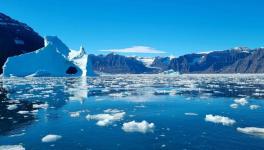Birds with Distinctive Traits at Higher Risk of Extinction: Research

Image Source: Wikimedia Commons. Use for representation only.
A healthy ecosystem marks its robustness by the diversity of species inhabiting it with diverse organisms performing a variety of roles to keep it healthy. In every ecosystem, the presence of some species is always special with distinctive functions crucial for the sustenance of the system.
In many cases, the loss of such species can be irreplaceable. Ironically, man-made climate change is inducing the extinction of species worldwide. And, if distinctive species become extinct, it can impact all of us adversely.
Two studies published recently hint at this concerning situation. Both the studies, conducted on birds, suggest that the ones most likely to become extinct have distinctive features and probably irreplaceable functions in the ecosystems they inhabit and thus driving the avian world towards homogenisation.
For example, toucans with their large beaks eat and disperse seeds and fruits that are too large for other birds to eat in the South American rainforests. Along with toucans, vultures, ibises and other such birds having distinctive features and critical functions are the first to become extinct, suggests one of the studies while the other study predicts that communities are likely to grow more alike as species move to cooler regions due to global warming.
Experts believe that the studies will encourage conservationists to have a renewed vision of biodiversity. Jedediah Brodie, an ecologist at the University of Montana, USA, said, “The impact of human actions can actually be worse than what we might think just based on species tallies alone.”
In one study, published in Current Biology, Emma Hughes of the University of Sheffield, measured the beak size and shape, lower limb, wing length and body sizes of 8,500 bird specimens in the museum for several years. Hughes and her colleagues used statistical techniques to list the similarities and dissimilarities among the species based on these traits.
Next, the team of researchers removed those birds from the chart that are most likely to go extinct in accordance with the International Union for Conservation of Nature’s Red List of threatened species. They found that the most threatened species are those having distinctive physical traits and ecosystem functions. The researchers removed birds sequentially from most to least threatened and found that toucans, hornbills, hummingbirds and others with distinctive features dropped out while birds with similar traits remained.
They also enumerated the geographical locations where the extinction trend may hit the hardest and found that out of the 14 major habitats, 12 will be affected by species homogenisation. The most affected regions, as the research found, will be Vietnam, Cambodia, the Himalayan foothills and islands like Hawaii, where honeycreepers have already gone extinct. Brodie said, “In some cases, there are no other organisms that can replace the unique ecological roles that these species play.”
The other study, led by ecologist Alke Voskamp, of Senckenberg Biodiversity and Climate Research Centre, found a driving force of species homogenisation—climate change-induced shift in birds’ habitats.
Voskamp’s team mapped the range at which birds can move. In their sample of 9,882 bird species (which is compiled by BirdLife International) they applied projections from the models of global climate only to predict where these species can find their homes by 2080. The researchers also determined how the changed distribution of the bird species will change the structure of bird communities.
Their analysis revealed that tropical and sub-tropical regions are most prone to lose species with many of them will go extinct and the rest will shift their range. Also, the remaining species will be alike in their traits to be able to survive in the conditions pertained to be altered by climate change. Voskamp’s team published their findings in the journal Proceedings of the Royal Society B.
The northern part of North America and Eurasia will gain bird species migrating from regions that are getting warmer. However, even this will not induce species diversity as the newcomers are likely to be same features as those residing there already.
Get the latest reports & analysis with people's perspective on Protests, movements & deep analytical videos, discussions of the current affairs in your Telegram app. Subscribe to NewsClick's Telegram channel & get Real-Time updates on stories, as they get published on our website.























